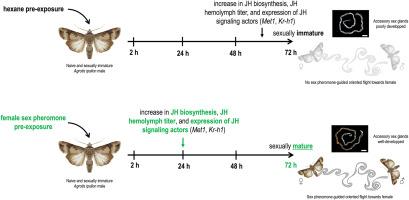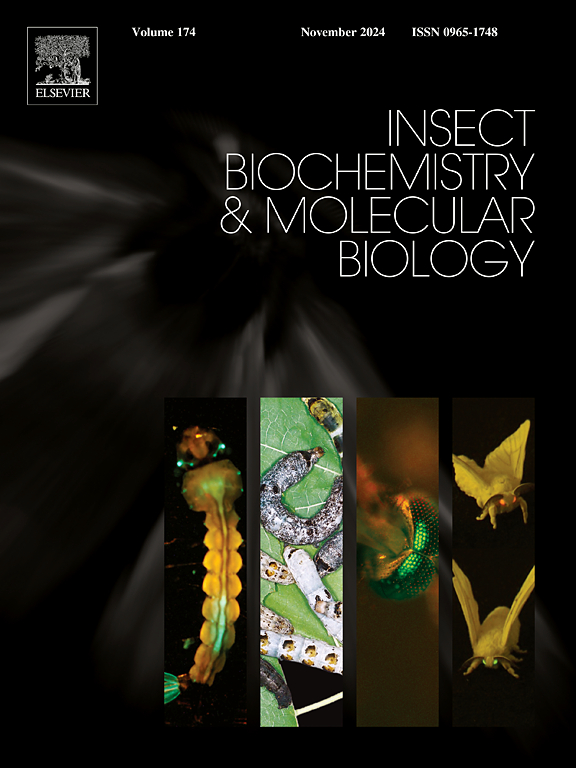昆虫信息素诱导雄性性成熟过程中的内分泌反应。
IF 3.7
2区 农林科学
Q2 BIOCHEMISTRY & MOLECULAR BIOLOGY
引用次数: 0
摘要
在动物中,性成熟的标志是生殖行为的发展与生育能力的获得同步,这个时间受到化学感觉经验的影响。在naïve和不成熟的个体中,暴露于性信息素可能会加速性发育,并且这种信息素诱导的机制尚未完全确定。研究人员发现,将未成熟的雄性蛾预先暴露于雌性蛾的性信息素中,会导致性信息素引发的定向飞行行为的早期增加,以及产生精液蛋白的副性腺(ASGs)的成熟。同时,幼崽激素(JH)的生物合成和循环量随着JH受体甲基戊二烯耐受性1 (Met1)和JH诱导转录因子kr本文章由计算机程序翻译,如有差异,请以英文原文为准。

Endocrine responses in the pheromone induction of male sexual maturation in an insect
In animals, sexual maturation is marked by the development of reproductive behaviors in synchronism with the acquisition of fertility, and this timing is influenced by chemosensory experiences. In naïve and immature individuals, exposure to sex pheromones may accelerate sexual development, and mechanisms underlying this pheromone induction are not fully identified. Using the moth Agrotis ipsilon, we showed that pre-exposure of immature males to female sex pheromones led to early increases in the performance of sex pheromone-triggered oriented flight as well as in the maturation of accessory sex glands (ASGs) producing seminal proteins. Conjointly, biosynthesis and circulating amounts of juvenile hormone (JH) raised with an upregulation of the expression of JH receptor, Methoprene-tolerant 1 (Met1) and the JH-inducible transcription factor, Krüppel homolog 1 (Kr-h1) in ASGs and the primary olfactory centers, the antennal lobes (ALs). In the sex pheromone pre-exposed immature males, the loss of function of Met1 or Kr-h1 caused a reduction in the induction of the sex pheromone behavioral responsiveness and the ASG secretory activity. Taken together, our results showed that the accelerated effects of sex pheromone pre-exposure on male sexual maturation are mediated by increased JH biosynthesis. This ultimately leads to early induction of JH signaling in ASGs for seminal protein production and in ALs for the central processing of pheromone information, which causes the display of sexual behavior in male A. ipsilon. Finally, this study expands our understanding of endocrine mechanisms by which animals can modulate their fitness according to past olfactory experiences.
求助全文
通过发布文献求助,成功后即可免费获取论文全文。
去求助
来源期刊
CiteScore
7.40
自引率
5.30%
发文量
105
审稿时长
40 days
期刊介绍:
This international journal publishes original contributions and mini-reviews in the fields of insect biochemistry and insect molecular biology. Main areas of interest are neurochemistry, hormone and pheromone biochemistry, enzymes and metabolism, hormone action and gene regulation, gene characterization and structure, pharmacology, immunology and cell and tissue culture. Papers on the biochemistry and molecular biology of other groups of arthropods are published if of general interest to the readership. Technique papers will be considered for publication if they significantly advance the field of insect biochemistry and molecular biology in the opinion of the Editors and Editorial Board.

 求助内容:
求助内容: 应助结果提醒方式:
应助结果提醒方式:


